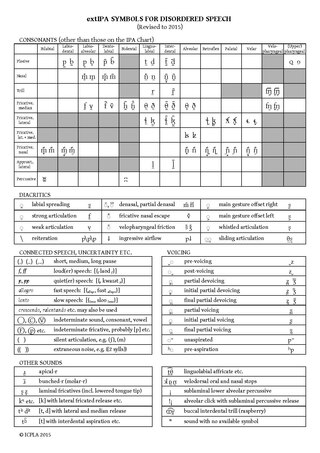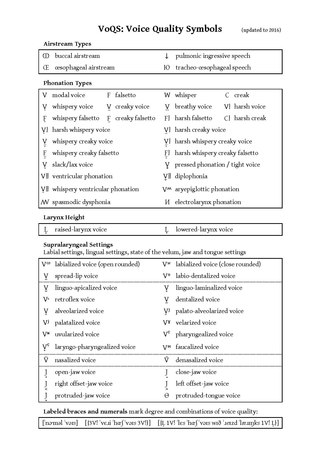Breathy voice is a phonation in which the vocal folds vibrate, as they do in normal (modal) voicing, but are adjusted to let more air escape which produces a sighing-like sound. A simple breathy phonation,, can sometimes be heard as an allophone of English between vowels, such as in the word behind, for some speakers.
A fricative is a consonant produced by forcing air through a narrow channel made by placing two articulators close together. These may be the lower lip against the upper teeth, in the case of ; the back of the tongue against the soft palate in the case of German ; or the side of the tongue against the molars, in the case of Welsh. This turbulent airflow is called frication.

The International Phonetic Alphabet (IPA) is an alphabetic system of phonetic notation based primarily on the Latin script. It was devised by the International Phonetic Association in the late 19th century as a standardized representation of speech sounds in written form. The IPA is used by lexicographers, foreign language students and teachers, linguists, speech–language pathologists, singers, actors, constructed language creators, and translators.

In articulatory phonetics, the place of articulation of a consonant is a location along the vocal tract where its production occurs. It is a point where a constriction is made between an active and a passive articulator. Active articulators are organs capable of voluntary movement which create the constriction, while passive articulators are so called because they are normally fixed and are the parts with which an active articulator makes contact. Along with the manner of articulation and phonation, the place of articulation gives the consonant its distinctive sound.
The term phonation has slightly different meanings depending on the subfield of phonetics. Among some phoneticians, phonation is the process by which the vocal folds produce certain sounds through quasi-periodic vibration. This is the definition used among those who study laryngeal anatomy and physiology and speech production in general. Phoneticians in other subfields, such as linguistic phonetics, call this process voicing, and use the term phonation to refer to any oscillatory state of any part of the larynx that modifies the airstream, of which voicing is just one example. Voiceless and supra-glottal phonations are included under this definition.

The voiced labial–palatalapproximant is a type of consonantal sound, used in some spoken languages. It has two constrictions in the vocal tract: with the tongue on the palate, and rounded at the lips. The symbol in the International Phonetic Alphabet that represents this sound is ⟨ɥ⟩, a rotated lowercase letter ⟨h⟩, or occasionally ⟨jʷ⟩, which indicates with a different kind of rounding.

The voiceless epiglottal or pharyngeal trill, or voiceless epiglottal fricative, is a type of consonantal sound, used in some spoken languages. The symbol in the International Phonetic Alphabet that represents this sound is ⟨ʜ⟩, a small capital version of the Latin letter h, and the equivalent X-SAMPA symbol is H\.
In phonetics, a trill is a consonantal sound produced by vibrations between the active articulator and passive articulator. Standard Spanish ⟨rr⟩ as in perro, for example, is an alveolar trill.
In phonetics, a flap or tap is a type of consonantal sound, which is produced with a single contraction of the muscles so that one articulator is thrown against another.

A pharyngeal consonant is a consonant that is articulated primarily in the pharynx. Some phoneticians distinguish upper pharyngeal consonants, or "high" pharyngeals, pronounced by retracting the root of the tongue in the mid to upper pharynx, from (ary)epiglottal consonants, or "low" pharyngeals, which are articulated with the aryepiglottic folds against the epiglottis at the entrance of the larynx, as well as from epiglotto-pharyngeal consonants, with both movements being combined.

Strident vowels are strongly pharyngealized vowels accompanied by an (ary)epiglottal trill, with the larynx being raised and the pharynx constricted. Either the epiglottis or the arytenoid cartilages thus vibrate instead of the vocal cords. That is, the epiglottal trill is the voice source for such sounds.
The term stiff voice describes the pronunciation of consonants or vowels with a glottal opening narrower, and the vocal folds stiffer, than occurs in modal voice. Although there is no specific IPA diacritic for stiff voice, the voicing diacritic may be used in conjunction with the symbol for a voiced consonant. In Bru, for example, stiff-voiced vowels have tenseness in the glottis and pharynx without going so far as to be creaky voiced, whereas slack-voiced vowels are lax in the glottis without going so far as to be breathy voice.
In phonetics, advanced tongue root (ATR) and retracted tongue root (RTR) are contrasting states of the root of the tongue during the pronunciation of vowels in some languages, especially in Western and Eastern Africa, but also in Kazakh and Mongolian. ATR vs RTR was once suggested to be the basis for the distinction between tense and lax vowels in European languages such as German, but that no longer seems tenable.
Laryngeal consonants are consonants with their primary articulation in the larynx. The laryngeal consonants comprise the pharyngeal consonants, the glottal consonants, and for some languages uvular consonants.
The voiced epiglottal or pharyngeal tap or flap is not known to exist as a phoneme in any language. However, it exists as the intervocalic voiced allophone of the otherwise voiceless epiglottal stop of Dahalo and perhaps of other languages. It may also exist in Iraqi Arabic, where the consonant 'ayn is too short to be an epiglottal stop, but has too much of a burst to be a fricative or approximant.

The Extensions to the International Phonetic Alphabet for Disordered Speech, commonly abbreviated extIPA, are a set of letters and diacritics devised by the International Clinical Phonetics and Linguistics Association to augment the International Phonetic Alphabet for the phonetic transcription of disordered speech. Some of the symbols are used for transcribing features of normal speech in IPA transcription, and are accepted as such by the International Phonetic Association.
Faucalized voice, also called hollow voice or yawny voice, is a vocal quality of speech production characterized by the vertical expansion of the pharyngeal cavity due to the lowering of the larynx. It is termed faucalized because of the stretching of the fauces and visible narrowing of the faucial pillars in the back of the oral cavity. During faucalized voice, the sides of pharynx expand outward and the larynx descends and tilts forward. The term "yawny voice" is appropriate to compare this voice quality to the physiological act of yawning. Its opposite is harsh voice, a vocal quality produced when the pharynx is contracted and the larynx raised. Faucalized voice is not to be confused with breathy voice, which involves relaxed vocal folds, greater velocity of airflow through the glottis and produces a lower pitch sound. Faucalized voice involves the forward tilting of the larynx which stretches the vocal folds and produces a higher pitch sound, despite the increased volume of the pharyngeal cavity.
IPA Braille is the modern standard Braille encoding of the International Phonetic Alphabet (IPA), as recognized by the International Council on English Braille.

Voice Quality Symbols (VoQS) are a set of phonetic symbols used to transcribe disordered speech for what in speech pathology is known as "voice quality". This phrase is usually synonymous with phonation in phonetics, but in speech pathology encompasses secondary articulation as well.
John Henry Esling, is a Canadian linguist specializing in phonetics. He is a Professor Emeritus of Linguistics at the University of Victoria, where he taught from 1981 to 2014. Esling was president of the International Phonetic Association from 2011 to 2015 and a co-editor of the 1999 Handbook of the International Phonetic Association.







